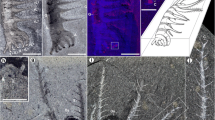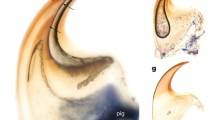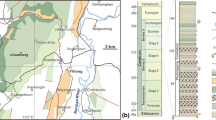Abstract
The evolutionary success of arthropods, the most abundant and diverse animal group, is mainly based on their segmented body and jointed appendages, features that had evolved most likely already before the Cambrian. The first arthropod-like animals, the lobopodians from the Early Cambrian, were unsclerotized and worm-like, and they had unjointed tubular legs. Here we describe the first three-dimensionally preserved Cambrian lobopodian. The material presented of Orstenotubulus evamuellerae gen. et sp. nov. is the smallest and youngest of a lobopodian known. O. evamuellerae shows strikingly detailed similarities to Recent tardigrades and/or onychophorans in its cellular-structured cuticle and the telescopic spines. It also shows similarities to other, longer known lobopodians, but which are ten times as large as the new form. These similarities include the finely annulated body and legs, which is characteristic also for Recent onychophorans, and paired humps continuing into spines situated dorsally to the leg insertions, a feature lacking in the extant forms. The morphology of O. evamuellerae not only elucidates our knowledge about lobopodians, but also aids in a clearer picture of the early evolution of arthropods. An example is the single ventral gonopore between a limb pair of O. evamuellerae, which indicates that a single gonopore, as developed in onychophorans, tardigrades, pentastomids, myriapods and insects, might represent the plesiomorphic state for Arthropoda, while the paired state in chelicerates and crustaceans was convergently achieved. Concerning life habits, the lateral orientation of the limbs and their anchoring spines of the new lobopodian imply that early arthropods were crawlers rather than walkers.
Similar content being viewed by others
References
Maas A, Waloszek D, Chen J Y, et al. Phylogeny and life habits of early arthropods—predation in the early Cambrian sea. Prog Nat Sci, 2004, 14: 1–9
Waloszek D, Chen J Y, Maas A, et al. Early Cambrian arthropods—new insights into arthropod head and structural evolution. Arthr Str Dev, 2005, 34: 189–205
Conway Morris S, Whittington H B, Briggs D E G, et al. Atlas of the Burgess Shale. London: The Palaeontological Association, 1982
Ramsköld L, Hou X G. New early Cambrian animal and onychophoran affinities of enigmatic metazoans. Nature, 1991, 351: 225–228
Ramsköld L. Homologies in Cambrian Onychophora. Lethaia, 1992, 25: 443–460
Chen J Y, Zhou G Q, Ramsköld, L. A new Early Cambrian onychophoran-like animal, Paucipodia gen. nov., from the Chengjiang fauna, China. Trans R Soc Edinb, Earth Sci, 1994, 85: 275–282
Hou X G, Bergström, J. Cambrian lobopodians—Ancestors of extant onychophorans? Zool J Linn Soc, 1995, 114: 3–19
Budd G E, Peel J S. A new xenusiid lobopod from the Early Cambrian Sirius Passet fauna of north Greenland. Palaeontology, 1998, 41: 1201–1213
Ramsköld L, Chen J Y. Cambrian lobopodians: morphology and phylogeny. In: Edgecombe G D, ed. Arthropod Fossils and Phylogeny. New York: Columbia University Press, 1998. 107–150
Maas A, Waloszek D. Cambrian derivatives of the early arthropod stem lineage, pentastomids, tardigrades and lobopodians—an ‘Orsten’ perspective. Zool Anz, 2001, 240: 449–457
Monge-Nájera J, Hou X G. Disparity, decimation and the Cambrian ‘explosion’: comparison of early Cambrian and present faunal communities with emphasis on velvet worms (Onychophora). Rev Biol Trop, 2002, 48: 333–351
Bergström J, Hou X G. Cambrian Onychophora or xenusians. Zool Anz, 2001, 240: 237–245
Dzik J. Early Cambrian lobopodian sclerites and associated fossils from Kazakhstan. Palaeontology, 2003, 46: 93–112
Bergström J, Hou X G. Chengjiang arthropods and their bearing on early arthropod evolution. In: Edgecombe G D, ed. Arthropod Fossils and phylogeny. New York: Columbia Univ Press, 1998. 151–184
Whittington H B. The lobopod animal Aysheaia pedunculata Walcott, Middle Cambrian, Burgess Shale, British Columbia. Phil Trans R Soc London, B, 1978, 284: 165–197
Hou X G, Aldridge R J, Bergström J, et al. The Cambrian fossils of Chengjiang, China—The Flowering of Early Animal Life. Malden: Blackwell, 2004
Liu J, Shu D G, Han J, et al. A large xenusiid lobopod with complex appendages from the Lower Cambrian Chengjiang Lagerstätte. Acta Pal Pol, 2006, 51: 215–222
Waloszek D. The ‘Orsten’ window—a three-dimensionally preserved Upper Cambrian meiofauna and its contribution to the understanding of the evolution of Arthropoda. Pal Res, 2003, 7: 71–88
Mass A, Braun A, Dong X P, et al. The ‘Orsten’—More than a Cambrian Konservat-Lagerstätte yielding exceptional preservation. Palaeoworld, 2006, 15: 266–282
Storch V, Ruhberg H. Onychophora. In: Harrison F W, Rice M E, eds. Microscopic Anatomy of Invertebrates. New York: Wiley, 1993. 11–56
Dzik J, Krumbiegel G. The oldest ‘onychophoran’ Xenusion: a link connecting phyla? Lethaia, 1989, 22: 169–181
Conway Morris S. A new Metazoan from the Cambrian Burgess Shale of British Columbia. Palaeontology, 1977, 20: 623–640
Liu J, Shu D G, Han J, et al. A rare lobopod with well-preserved eyes from Chengjiang Lagerstätte and its implications for origin of arthropods. Chin Sci Bull, 2004, 49(9): 1063–1071
Kristensen R M. Sense Organs of Two Marine Arthrotardigrades (Heterotardigrada, Tardigrada). Acta Zool, 1981, 62: 27–40
Kristensen R M, Higgins R P. Revision of Styraconyx (Tardigrada: Halechiniscidae), with Description of Two New Species from Disko Bay, West Greenland. Smith Contr Zool, 1984, 391: 1–40
Mayer G. Origin and differentiation of nephridia provide no support for the Articulata. Zoomorphology, 2006, 125: 1–12
Budd G E. Why are arthropods segmented? Evol Dev, 2001, 3: 332–342
Walker M H, Tait N N. Studies of embryonic development and the reproductive cycle in ovoviviparous Australian Onychophora (Peripatopsidae). J Zool, 2004, 264: 333–354
Bertolani R, Grimaldi De Zio S, D’Addabbo Gallo M, et al. Postembryonic development in heterotardigrades. Monitore Zoologico Italiano (N.S.), 1984, 18: 307–320
Walossek D, Müller K J. Upper Cambrian stem-lineage crustaceans and their bearing upon the monophyletic origin of Crustacea and the position of Agnostus. Lethaia, 1990, 23: 409–427
Author information
Authors and Affiliations
Corresponding author
About this article
Cite this article
Maas, A., Mayer, G., Kristensen, R.M. et al. A Cambrian micro-lobopodian and the evolution of arthropod locomotion and reproduction. Chin. Sci. Bull. 52, 3385–3392 (2007). https://doi.org/10.1007/s11434-007-0515-3
Received:
Accepted:
Issue Date:
DOI: https://doi.org/10.1007/s11434-007-0515-3




